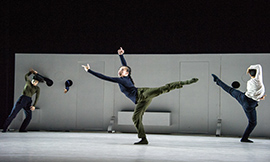
Through the unique medium of body, the lens is focused at the individuals, who are hustling in the diverse metropolis - Shanghai, and tries to explore the relationship between these individuals and the space. Living in such a city, everyone is subject to tangible or intangible constraints. In this work, the real society is scaled down to a miniature. The model and device constructed on the stage represent and symbolize the relationship between the individual and the society as well as between the body and the space. The work intends to discovery the alien aesthetics hidden in the human body, the tenacious vitality of the human beings in a limited space, and the inner momentum generated through resistance against the space. Du YanhaoDu Yanhao, who lives in Shanghai now, youth director and performance artist. Co opera troupes include: Shiki Theatre Company, New Zealand Black Grace Dance Company, New Zealand Footnote Dance Company, Scotland Janis Claxton Dance Company, Beijing LDTX Dance Company, Shanghai Xie Xin Dance Theatre, Punchdrunk International, SMG Shanghai Media & Entertainment Group, D.Lab Dance, Ear Childrens Theatre. He has cooperated with the top artists of the world include: Asari Keita, Kato Keiji, Sang Jijia, Ma Bo, Li Hanzhong, Liu Bin, Zi Wei, Wang Jianjun, Hu Songwei, Wang Jianhui, Jiri Kylian, Paul Taylor, Malia Johnston, Janis Claxton, Neil leremia, Sarah Foster, Eyal Dadon, Taane Mate, Tairoa Royal, Raewyr Hill and so on. He has visited more than 20 countries for the exchange of art festivals. Performances are involved in dance theatres, musicals, dramas, dance videos, cross boundary cooperation and other fields. Musical and drama experience: the British Punchdrunk made the invading drama "Sleep No More" presented by SMG LIVE of Shanghai Media & Entertainment Group. Andrew Lloyd Webber composes the Japanese and Chinese versions of the musical CATS Japanese dramatist Asari Keita wrote and directed the musical Ri Koran. Main works: Newtons Cradle Of Flesh And Bone, Doll, Two Person Structure and so on.
Dance
2018